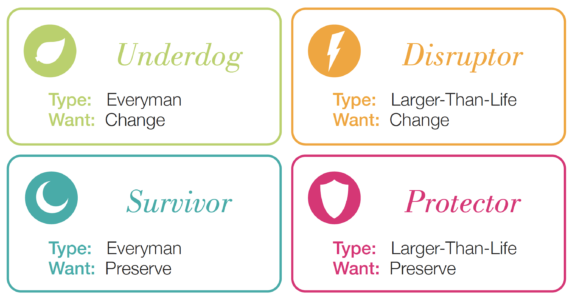In my last post, we discussed how a protagonist is the driving force behind every story. And there are four distinct types of protagonists, and different writers are drawn to different ones. They all exist on a spectrum, between what a character wants and his or her personality. Which do you gravitate towards? Let’s take a look.
The Four Archetypes
When you intersect the protagonist’s personality type with what she wants, you get one of four archetypes: underdog, disruptor, survivor, and protector. The storytelling superpower matrix shows how we get each of these archetypes from looking at character type and desire. The underdog is an everyman character who wants to change something in himself or the world around him. The disruptor also wants to effect change, but in this case the character is in the larger-than-life category. The survivor and protector, on the other hand, both want to preserve something in their lives or their world, with the survivor as the everyman type and the protector as a larger-than-life hero.
Storytelling Superpower Matrix

As writers, we each tend to gravitate toward one of these archetypes (underdog, disruptor, survivor, and protector) over the other three. Look at stories you’ve written or ones you love to read. Chances are, one of these archetypes keeps coming up again and again. Think about how you look at yourself and it’s likely that the archetype you most like to write (or read about) is the one you identify with the most. This is not to say that you never identify with the other types, but it’s likely that one of these resonates with you more than the others. I call this preferred archetype your “storytelling superpower.”
The reason to identify your storytelling superpower isn’t to set limitations or compartmentalize your creativity. Rather, when you understand your natural tendencies and preferences, it allows you to play to your strengths and stretch yourself beyond your comfort zone. After all, if one archetype tugs at your heartstrings more than the others, you’ll likely pour more passion and creative energy into crafting that character, which in turn will make your writing shine.
Three Layers of Character Development
As you’ll soon discover, each archetype has positive qualities as well as weaknesses. Understanding these pros and cons will help you ratchet up the stakes and increase the conflict in your story. You will also learn to identify aspects of your character that can be off-putting to your readers, making them want to stop reading altogether. Training yourself to identify these red flags will help you craft characters and stories your readers can’t help but love.
To understand each storytelling superpower archetype, you need to consider three layers of that character: her internal state, her external situation, and how readers will relate to her. In business, there is a technique called the SWOT analysis where you analyze an idea based on its strengths, weaknesses, opportunities, and threats. We’ll do a similar analysis here, only adding an extra layer to consider the reader relationship.
Character Analysis in Layers
Strengths and weaknesses are positive or negative traits internal to your character. Who is your character at his core and what does he believe in? Every protagonist brings some internal baggage with him to the story, and these qualities will affect how he reacts to various events that happen. These internal qualities are also somewhat fixed and consistent across different situations, which means that when your character finally does experience a transformation at this internal layer, it will feel significant to the reader.
The external layer—opportunities and threats—are situations that happen around or to your character. What scenarios bring out the best in your character? Which situations cause her to misbehave? And even more interesting, what environments can you create as the writer so as to create more conflict and tension for your protagonist? Conflict is what makes your story interesting and while in some rare circumstances the character’s internal state might be enough to create that tension, the juiciest conflict often arises from a mismatch between your protagonist’s internal qualities and the environment where she finds herself.
Finally, you must also consider the relationship your protagonist has with your reader. Which of your character’s internal qualities will your reader find engaging or alienating? Does he make choices or react to external situations in ways that resonate with readers, or are his behaviors off-putting? There are also certain signature stories (e.g. rags-to-riches, fish out of water, etc.) that tend to work better with some archetypes than the others. Knowing what these signature stories are will help you determine if you are crafting the best narrative for your character.
Ready to dive in? In my next post, we’ll discuss two of the four character archetypes, and we can see where your superpower lies.
This is the second in a series of articles on your Storytelling Superpower. For the first post, click here.







